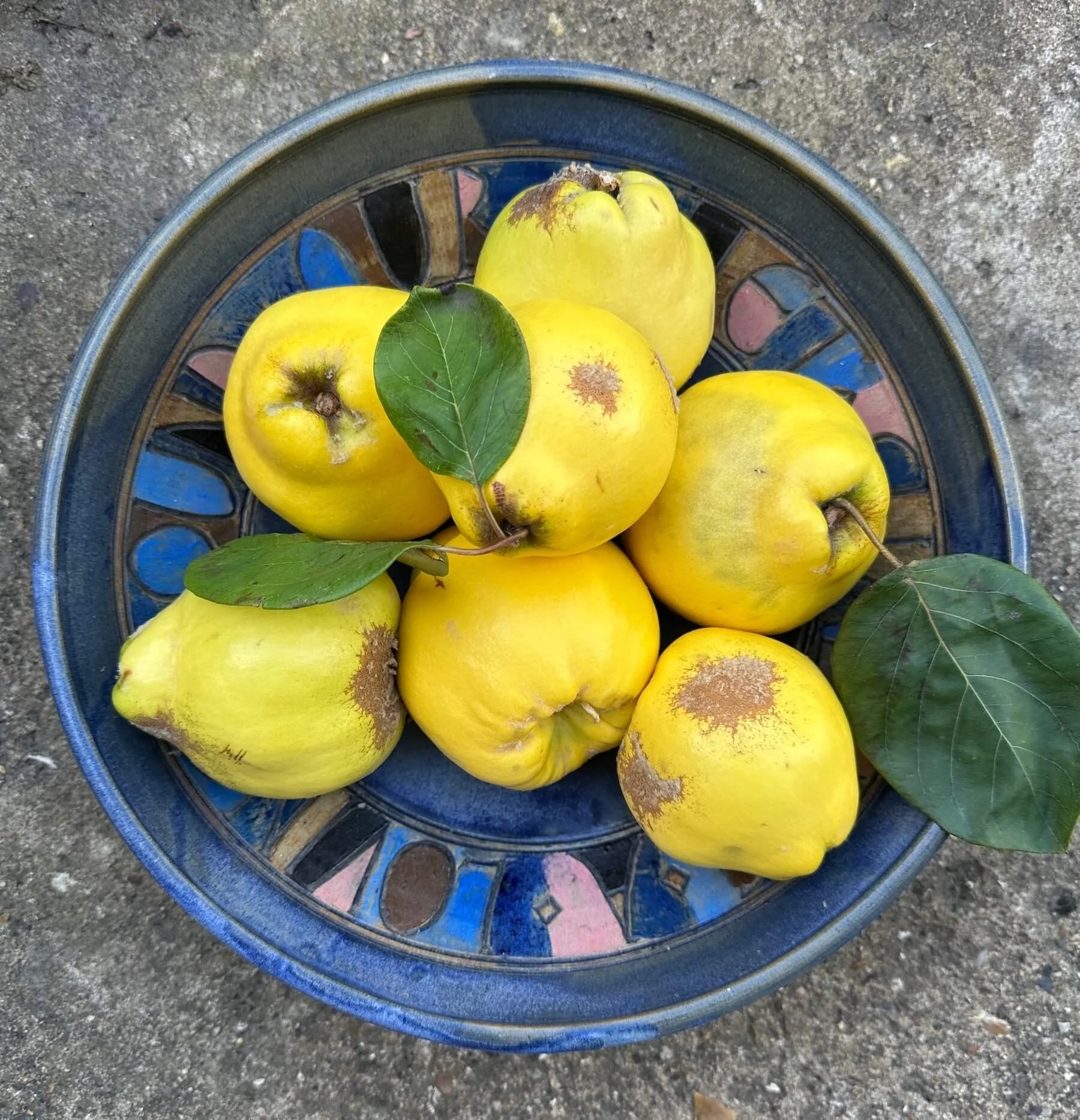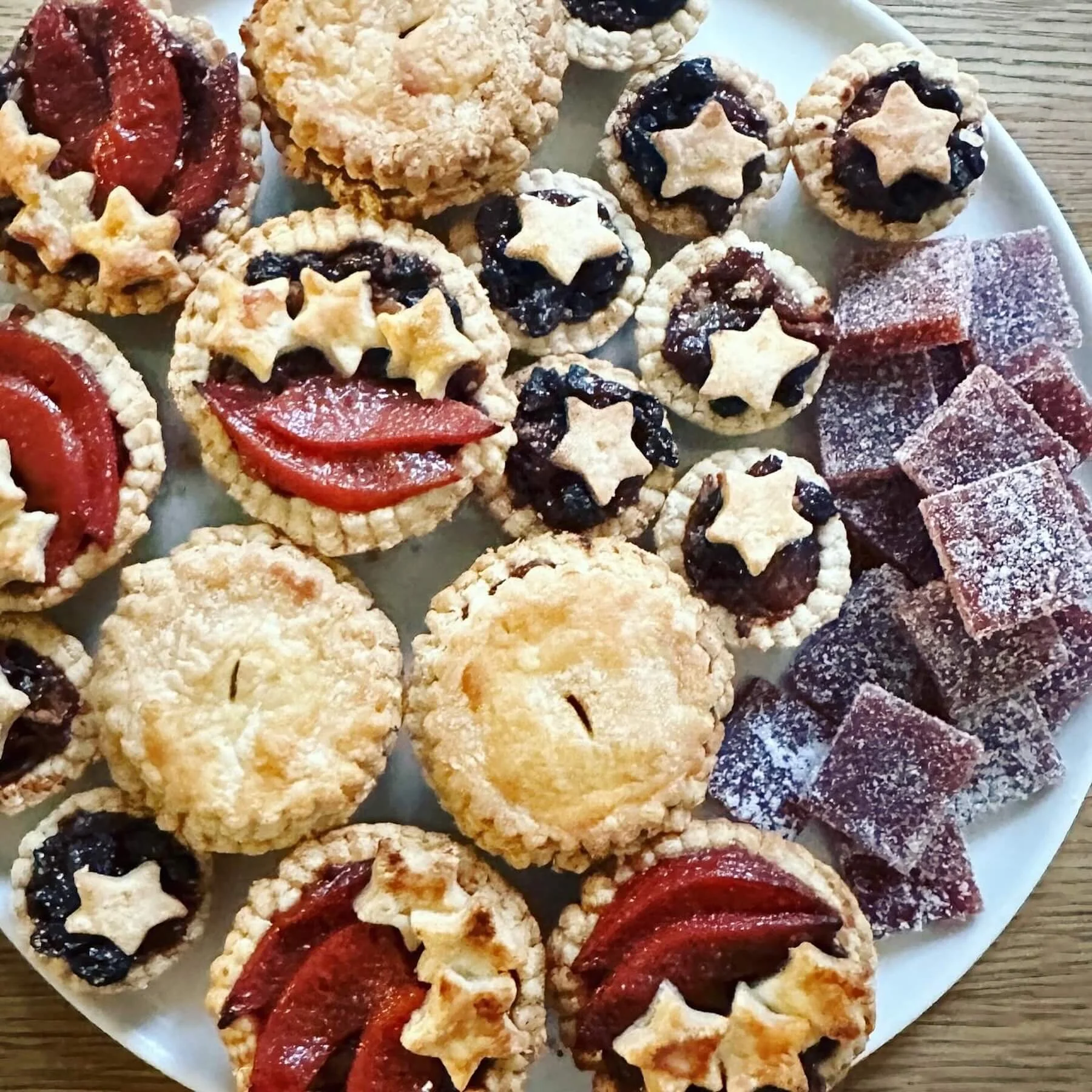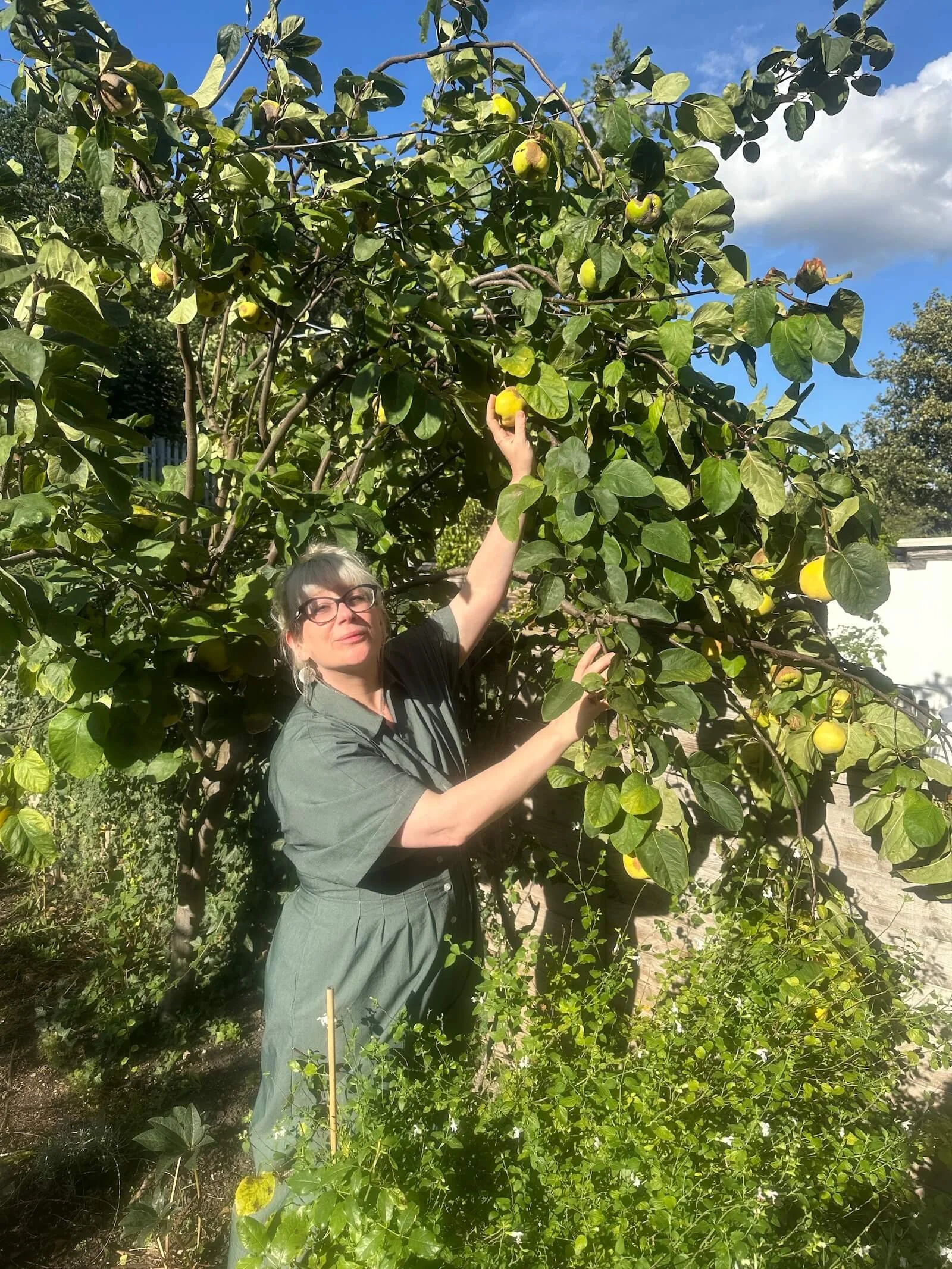Advertisement
Consuming Passions: Quinces
13 October 2025 · Consuming passions

In the UK (and the US) quince season is getting into full swing. Chef and food writer Clare Heal says it’s time to make membrillo, and plenty more besides…
By Clare Heal
Like many British children my introduction to quinces probably came via Edward Lear’s nonsense poem The Owl and the Pussycat.
The titular couple, as I’m sure you remember, are set on a destination wedding. They sail away (“for a year and a day”) to the Land Where The Bong Tree Grows. Once there they celebrate their union and then, post-ceremony, “dined on mince and slices of quince”.
Lear doesn’t specify how the quinces were cooked but the newlywed Owl and Pussycat would have had plenty of options. You can assume their quinces were cooked though as the fruit are generally too hard and sour to be eaten raw.
Visually a quince resembles a fat golden pear, a William perhaps, but somewhat lumpier. It’s texturally similar too, with that slightly grainy mouthfeel. The flavour when cooked is between a pear and an apple but more floral than either, uniquely perfumed and delicious.
History, culture and etymology
The Oxford Companion to Food tells us that quince originates in the Caucasus region and from there spread to the Levant and Europe around the end of the first millennium BC. Its journey predated that of the apple, so it’s likely that references to apples in ancient stories are actually quinces.
The Song of Solomon in the Bible is full of apples but the Hebrew word being translated is tappuach (תַּפּוּחַי) which is a general word for tree fruit. So it’s probable that the woman asking “Stay me with flagons, comfort me with apples: for I am sick of love” is really requesting quinces!
Likewise the “golden apple” in the Greek myth of Paris choosing between the goddesses was likely a quince, a fruit sacred to Aphrodite the goddess of beauty and love. The Romans also revered the quince, calling it melimelum which translates as “honey apple”—not because it was sweet but because it was often preserved in honey. Pliny writes at length about quinces in his Natural History, and the classical cookbook by Apicius instructs: “To Keep Quinces: Pick out perfect quinces with stems and leaves. Place them in a vessel, pour over honey and defrutum [a kind of reduced wine syrup] and you’ll preserve them for a long time.”
Getting hold of quinces
If you have space, I recommend growing your own quinces as a good way of ensuring a ready supply come autumn. They have beautiful pale pink blossoms in spring and the golden fruits are almost cartoonishly ample. My tree is only a few years old but I find it endlessly pleasing.
Quinces don’t tend to be available in supermarkets but search farmers’ markets and independent shops and you are likely to see them. Ask around and you may well find neighbours or community orchards who have trees but little ideas of what to do with the fruit and would, almost certainly, be delighted for you to take it off their hands (in return for a share of the preserved bounty).
Look for nice, big, smooth specimens (as these have less wastage) and handle them carefully as, despite being rock hard, quinces are sensitive souls and bruise very easily. A ripe quince will have no hint of green and its light coating of fuzz will rub off easily. Once picked they will keep in the fridge (or a cool cellar) for up to two months - wrap them in newspaper to keep them safe. Or put some in a bowl on the kitchen table and let the scent fill the room.
Preserves
Membrillo, the Spanish quince paste often eaten alongside slices of Manchego cheese, is probably the best known way of eating the fruit. At its simplest, membrillo is just quince purée cooked with an equal amount of sugar until ruby-red and so thick you can stand a spoon in it, then left to set. Jenny Chandler has a wonderfully simple recipe in The Food of Northern Spain.
The Spanish aren’t the only lovers of quince paste though. In France is is known as Cotignac, while Najmieh Batmanglij has a Persian version, thickened with corn flour and set with gelatin for a softer finish. She recommends cutting it into diamond shapes to serve and I love these kind of candies. Coated with sugar they look like jewels but I really like her suggestion of garnishing with pistachios or rose petals for something even fancier.
Mark Hix calls his membrillo-alike “quince cheese” and recommends serving with blue cheese, one of my all-time favourite combinations.
But your quince preserve possibilities aren’t limited to membrillo and other, similarly solid, sliceable pastes. The fruit’s high levels of pectin make it great for all manner of jams, jellies and marmalades. In fact, the word “marmelade” comes from the Portuguese name for quince, marmelo. Deborah Madison’s recipe for quince threads intriguingly mimics the appearance of shredded citrus peel with coarsely grated quinces. A marmelo marmalade if you like.
The best way to make a jelly is to boil quartered quinces with just enough water to cover until completely soft then strain this mixture through a jelly bag and reboil the liquid with an equal amount of sugar. Eliza Acton’s instructions from 1845 will still work today although I like the sound of Christine McFadden’s pink peppercorn version for a more modern twist.
Greek spoon sweets are somewhere between candied fruits in syrup and chunky jams. They are often offered to guests with tea or a drink and are popular as a topping for yoghurt. Aglaia Kremezi makes small jars of her quince spoon sweet which sound like they would make lovely presents.
Quinces also lend themselves to chutneys and pickles. Abra Berens offers a couple of different pickling brines that would suit them in Pulp, her guide to cooking with fruit. Or, if you have a sous vide machine, Dale Prentice’s version would go well alongside fatty cuts of meat, especially pork. And, far be it from me to presume to improve on the work of a Michelin-starred chef, but I make Jason Atherton’s pear and saffron chutney every year, substituting quinces for pears, and it is superb with a cheeseboard.
Sweet Things

A variety of quince treats prepared by the author
Simply poached quinces are a wonderful thing have around, the long slow cooking releasing their complexity and turning the flesh a dramatic sunset pink. They can be eaten as they are, with some yoghurt, custard or ice cream or baked into cakes, tarts and crumbles. Their perfume elevates the humblest dessert.

Quinces take on a hue of ‘dramatic sunset pink’ when poached
Even a completely pared back preparation—enough water to cover the fruit along with a generous amount of sugar - will lead to something pretty special after a couple of hours of simmering. I usually peel and quarter my quinces but don’t bother removing the cores - it’s a much easier task once they have softened and cooled.
Of course, extra ingredients bring their own rewards. Quince play well with all manner of other flavours. Citrus juice and zest are always welcome and they have great affinity for spices too. Add extra layers of interest by substituting some or all of the poaching liquid for wine, fruit juice or tea. Michelle Cranston’s spice poached quinces are a good starting point. I love her use of bay and star anise. Vegetarian restaurant The Gate use red wine and marsala in their version.
Combine with other fruits to make something even more interesting. Peter Gordon pairs his quinces with pineapple before using the mixture in a crumble and Ayva Tatlisi takes the fruit back to its Anatolian roots alongside sour cherries.
Slow roasting or baking works just as well as poaching to soften and sweeten quinces. Melanie Marsten adds rosemary which brings a spicy, woody note alongside honey, but her method lends itself well to other flavour combinations too.
It takes a while each October before I get bored with eating poached or roasted quince with just a little dairy for company but, once I do, my thoughts turn to traditional desserts. You can use a quince anywhere you’d use an apple or pear, instead of—or alongside—those more familiar fruit, it will bring a certain je ne sais quoi, elevating the humble crumble into something sublime. Go with your favourite apple recipe but add some quince or try Matt Tebbutt’s version which hooked me in with the walnuts in the topping. A tatin is another classic option where you can sub in quince for apple. Angela Redfern uses a combination of both in her tarte tatin, but you can go full quince if you fancy.
Or, what’s more comforting as the nights draw in than a steamed pudding? Frances Bissell’s individual puds demand to be served in a lake of custard. If you really forced me to choose though, cruelly made me pick just one quince-based dessert, I would plump for a frangipane tart. The crisp pâte sablée pastry in Damien Pignole’s version is the perfect textural contrast to the soft almond sponge and yielding poached quinces. Understated French elegance.
The only thing that could, perhaps sway me from that choice would be a trifle. So celebratory! You know you can trust Rowley Leigh with the important business of trifling. Naturally his includes a good slug of sherry.
For something lighter, quinces make beautiful ice cream or sorbet. In Frozen Desserts, Francisco Migoya makes that classic pairing with Manchego again, but as a sophisticated dessert rather than on the cheese board. His sorbet would be lovely on its own, without the extra cheesy faff. For those without an ice cream maker, a granita is very easy. Najmieh Batmanglij’s recipe for quince granita only requires that you scrape ice crystals with a fork every now and again to produce something light but rich-tasting.
Or what about a blancmange! When was the last time you ate a blancmange? Have you ever actually eaten a blancmange? They seem more like an idea from a vintage children’s book than a real dessert. And yet Janni Kyritsis and Roberta Muir have a wonderful looking blancmange recipe in Wild Weed Pie which seems simultaneously classic and modern.
Savoury dishes
It’s not all desserts and sweet things though. Oh no. Quinces are widely used in savoury dishes, especially in their native Caucasus region and across Turkey and Persia where sweet-and-sour flavour combinations are particularly popular. Bethany Kehdy’s version with veal (beef or lamb work too) would make a fabulous dinner party centrepiece. Or Aglaia Kremezi has a vegetarian alternative which is just as impressive.
Turkish dish Ayvali Kereviz combines quince with celeriac—another knobbly-but-flavoursome piece of produce—in a piquant braise. David Dale and Somer Sivrioglu’s recipe from Anatolia is very doable, and would be nice on its own with rice or bread or as part of a spread.
Moroccan cooking often uses fruit—we usually think of this as being dried apricots or prunes but quince is common too. Lulu Grimes uses it with with lamb and sweet spices in a tagine that comes together easily and just needs time to simmer, whilst Ghillie Basan matches it with roast duck.
Traditional British recipes often pair quince with game. This rabbit pie comes from the Bourke Street Bakery in Sydney, but feels very British in its vibe. Jeff Galvin’s daube of venison with quince and chestnuts is a winter dinner party favourite for me—easy to put together in advance but out-of-the-ordinary enough to feel like you made an effort. And I am eyeing Paul Gayler’s fabulous-sounding goose recipe as a possible Christmas dinner option if I can get it past my fussy niece and nephews.
The sweet-spicy combo also works well in lighter dishes. Quince and nuts aren’t just for the tarts and puddings. Trish Deseine doesn’t specify what leaves to use in her classy quince and walnut salad but I’d definitely recommend including some pale, bitter chicory in the mix. I love her use of the quince poaching syrup in vinaigrette.
Drinks
Don’t forget that quince make lovely drinks too. That poaching syrup is delicious as a cordial, topped up with sparkling water, or in cocktails like Abra Berens’ gin fizz. Or infuse the gin with quince from the start. Jane Grigson’s all-purpose fruit liqueur method works very well and I’ve often got a bottle or two lurking in the cupboard to give as emergency presents. Annette Ogrodnik Corona has a spiced Ukranian quince liqueur made with brandy, which also sounds delicious.
For non-alcoholic options, the dramatically purple Peruvian corn and fruit drink chicha morada, described by Morena Cuadra and Morena Escardó, sounds refreshing. And I love Ponche Navideño, a hot Christmas punch from Mexico in Bricia Lopez’s book Oaxaca. I’ll be serving it at my Christmas party this year, along with my now-traditional quince pies (just add poached quince to your regular mince pies). I’m sure the owl and the pussycat would approve.
Featured recipes
About the author
Clare Heal is a chef, food writer and cookery teacher. Her company Sauerpuss runs fermentation workshops in London and beyond. Subscribe to her Substack: In Good Taste
More from ckbk features
Look back on the recipes you’ve cooked to track your progress, and to see which dishes are due to be repeated
The best things come to those who wait. Ellen Manning celebrates the deep flavours which come from sitting back and letting time do its magic.
Pastry chef and cookbook obsessive Luciana Corrrêa profiles one of Brazil’s most well-known chefs.
Advertisement













